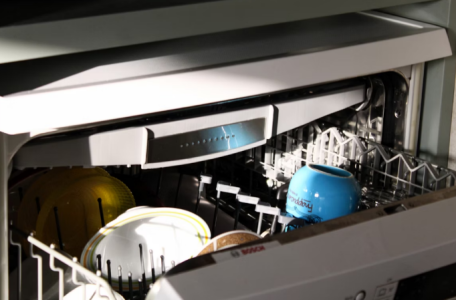This ‘80s drink is trending as a dishwasher cleaner—genius hack or terrible idea?
- Replies 0
Dishwashers are supposed to make life easier, but even these trusty appliances need attention once in a while.
Over time, they can accumulate soap scum, hard water deposits, and residue that leave dishes less than sparkling.
While there are plenty of standard solutions, a surprising retro option has resurfaced and caught the attention of homeowners. The answer for some people has been a nostalgic powdered drink from the 1980s.
Tang, once famous for its sweet citrus flavor and association with astronauts, contains citric acid that doubles as a cleaning agent.
People claim it works wonders in dishwashers by breaking down the very buildup that causes glasses and plates to come out cloudy.
Its fruity scent is a bonus, offering a light fragrance while it runs through a cycle. While the drink mix has faded in popularity as a beverage, it remains easy to find on grocery shelves.
Fans of this unconventional trick say it is inexpensive, non-toxic, and surprisingly effective. Even a certified Whirlpool technician has reportedly given approval to the method, noting how citric acid targets deposits inside the machine.
The process involves running the dishwasher empty, then adding about 12 ounces of Tang to the water before continuing the cycle. The citric acid then works to clear away grime, leaving the interior shinier.
Still, there are reasons to hesitate before making Tang your go-to dishwasher solution. Unlike vinegar or baking soda, Tang also contains sugar, dyes, and additives that are not ideal for regular use.
Also read: Cooking in your…dishwasher!? They say, “It turned out so good.”
Experts warn that its orange coloring could even stain white dishes if not used carefully. For that reason, vinegar or plain citric acid remain the first recommendations for maintenance cleaning.
To try the Tang method, users are advised to remove all dishes before running a hot water cycle. After letting the dishwasher run for about six to seven minutes, Tang is poured into the bottom where the water has pooled.
Once the door is shut and the cycle finishes, the appliance should be noticeably fresher. At that point, extra spot-cleaning may still be necessary, but the results can be impressive.
Also read: Your dishwasher deserves better—Here’s what you’ve been doing wrong
Using a sugary drink to clean an expensive appliance might sound questionable, but the hack has held its place for decades. For some, it remains a quick fix when no other cleaning products are available.
Others argue that more natural or chemical-free methods are safer and more effective long term. With mixed opinions, the Tang trick remains one of those viral solutions that sparks curiosity and skepticism alike.
Read next: Lemon in your dishwasher: Cleaning hack or myth?

Would you trust a childhood drink mix to clean your dishwasher, or do you prefer sticking with more traditional solutions like vinegar or baking soda? When it comes to maintaining an appliance that you use daily, would convenience ever outweigh caution? Share your thoughts and let us know whether you would try the Tang hack in your own kitchen.
Over time, they can accumulate soap scum, hard water deposits, and residue that leave dishes less than sparkling.
While there are plenty of standard solutions, a surprising retro option has resurfaced and caught the attention of homeowners. The answer for some people has been a nostalgic powdered drink from the 1980s.
Tang, once famous for its sweet citrus flavor and association with astronauts, contains citric acid that doubles as a cleaning agent.
People claim it works wonders in dishwashers by breaking down the very buildup that causes glasses and plates to come out cloudy.
Its fruity scent is a bonus, offering a light fragrance while it runs through a cycle. While the drink mix has faded in popularity as a beverage, it remains easy to find on grocery shelves.
Fans of this unconventional trick say it is inexpensive, non-toxic, and surprisingly effective. Even a certified Whirlpool technician has reportedly given approval to the method, noting how citric acid targets deposits inside the machine.
The process involves running the dishwasher empty, then adding about 12 ounces of Tang to the water before continuing the cycle. The citric acid then works to clear away grime, leaving the interior shinier.
Still, there are reasons to hesitate before making Tang your go-to dishwasher solution. Unlike vinegar or baking soda, Tang also contains sugar, dyes, and additives that are not ideal for regular use.
Also read: Cooking in your…dishwasher!? They say, “It turned out so good.”
Experts warn that its orange coloring could even stain white dishes if not used carefully. For that reason, vinegar or plain citric acid remain the first recommendations for maintenance cleaning.
To try the Tang method, users are advised to remove all dishes before running a hot water cycle. After letting the dishwasher run for about six to seven minutes, Tang is poured into the bottom where the water has pooled.
Once the door is shut and the cycle finishes, the appliance should be noticeably fresher. At that point, extra spot-cleaning may still be necessary, but the results can be impressive.
Also read: Your dishwasher deserves better—Here’s what you’ve been doing wrong
Using a sugary drink to clean an expensive appliance might sound questionable, but the hack has held its place for decades. For some, it remains a quick fix when no other cleaning products are available.
Others argue that more natural or chemical-free methods are safer and more effective long term. With mixed opinions, the Tang trick remains one of those viral solutions that sparks curiosity and skepticism alike.
Read next: Lemon in your dishwasher: Cleaning hack or myth?
Key Takeaways
- Tang, once famous for its sweet citrus flavor and association with astronauts, contains citric acid that doubles as a cleaning agent.
- Even a certified Whirlpool technician has reportedly given approval to the method.
- Experts warn that its orange coloring could even stain white dishes if not used carefully.
- With mixed opinions, the Tang trick remains one of those viral solutions that sparks curiosity and skepticism alike.







